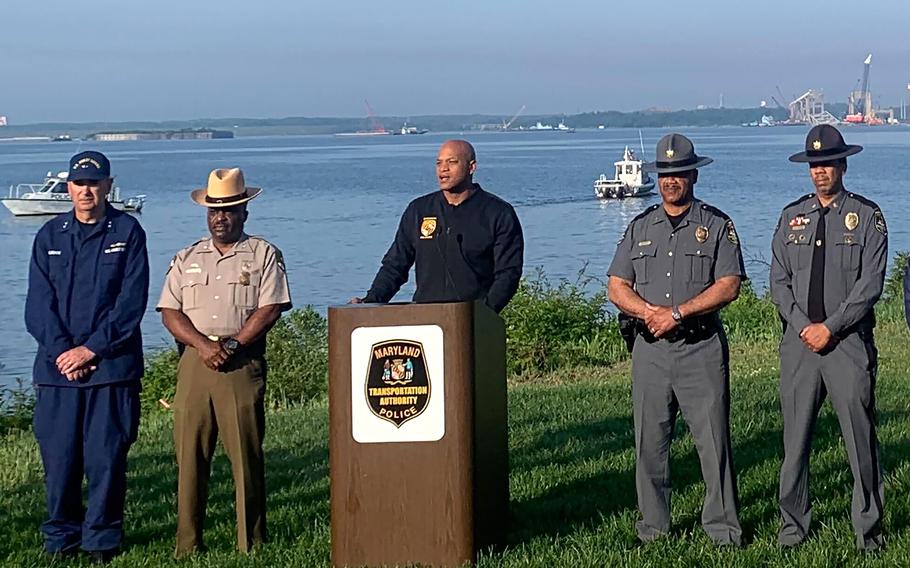
Gov. Wes Moore, center, held a news conference on May 21, 2024, one day after the container ship Dali was refloated. (Hayes Gardner, Baltimore Sun/TNS)
BALTIMORE (Tribune News Service) — A 400-foot-wide, 50-foot-deep channel into the Baltimore harbor opened Tuesday after officials claimed victory over one of the largest hurdles in clearing the aftermath of the Francis Scott Key Bridge collapse.
Updating reporters on the timeline at a Tuesday morning news conference in front of a noticeably different Patapsco River, Coast Guard Rear Adm. Shannon Gilreath said the deep-draft channel would open Tuesday “for 24/7 operations.” He added that the Baltimore harbor’s main 700-foot-wide channel was still on target to reopen by the end of the month.
The channel that opened Tuesday is the largest, and deepest, marine route into the Port of Baltimore to open since the Key Bridge collapsed in March, immediately cutting off maritime traffic into the port. Gilreath said Monday that about 500 commercial vessels have passed through temporary channels opened by Key Bridge Response Unified Command in the eight weeks since the March 26 collapse, which killed six construction workers.
The Coast Guard later said in a noon bulletin that 24-hour commercial vessel traffic through the Fort McHenry Limited Access Channel had commenced. Deep draft vessels, which must be accompanied by a Maryland pilot and two escort tugboats, have priority in the 50-foot-deep channel, though shallower commercial ships can use the three existing alternate channels.
Recreational boats can now traverse around the wreckage 24 hours a day through a temporary channel under a still-standing section of bridge on the Sollers Point side, the bulletin says.
The new channel’s opening comes a day after crews moved the Dali, the cargo ship that caused the collapse when it hit a bridge support column, out of the wreckage site and to Seagirt Marine Terminal. Moving the freighter, a 21-hour-long process that came after weeks of preparation and the use of explosive charges to rip apart a piece of truss sitting on the bow, was the last obstacle for crews attempting to clear the federal channel.
The Maryland Transportation Authority, meanwhile, is leading efforts to clear wreckage sitting outside of the federal channel, and Gilreath said that work should be complete “sometime in June.”
Though crews still have bridge wreckage to clear, moving the Dali with five tugboats represented a pivotal moment for the Unified Command, a multiagency effort formed shortly after the collapse and led by the Coast Guard, the Army Corps of Engineers, the Maryland Transportation Authority, the Maryland Department of the Environment and state police. The agencies said Monday they would depart their joint headquarters at the Maryland Cruise Terminal and head back to their respective worksites.
“People said that it could take months to get this point,” Gov. Wes Moore said at Tuesday morning’s news conference at the transportation authority police headquarters. “This team got it done in a matter of weeks.”
Moore hailed the Unified Command team and private salvage entities who have helped to clear the wreckage, as well as state and federal government leadership and others among “all sectors of society” who have stepped up amid the response effort, “from the State House to mom-and-pop lunch counters over in Dundalk and over in Turner Station.”
The Democratic governor continued to make a push for bipartisan support for legislation that would ensure the federal government covers 100% of the cost of a new bridge connecting Sollers Point to Hawkins Point. The state estimates the new bridge to cost up to $1.9 billion and take until fall 2028 to open.
Some of those costs are expected to be recouped by insurance claims and litigation. Calling initial findings in a preliminary National Transportation Safety Board report on what led to the bridge collapse “troubling,” Moore said Tuesday that “those who need to be held accountable for what happened on March 26 need to be held accountable for it in every way, shape and form.”
He noted, though, that ongoing work with the Maryland Attorney General’s office will be a “lengthy process” and that federal funding in advance would enable the state to pursue an “aggressive” timeline for rebuilding the bridge.
Baltimore Sun reporter Hayes Gardner contributed to this report.
©2024 Baltimore Sun.
Visit baltimoresun.com.
Distributed by Tribune Content Agency, LLC.